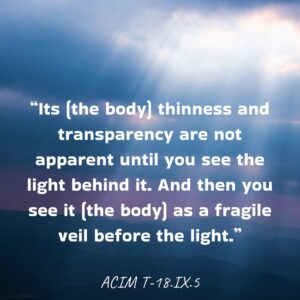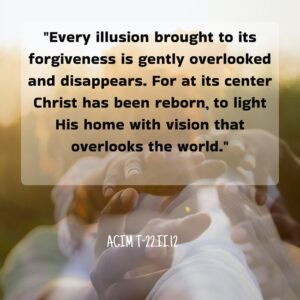
Seeing the Real World
A Course in Miracles tells us this about forgiveness and vision:
“For forgiveness literally transforms vision, and lets you see the real world reaching quietly and gently across chaos, removing all illusions that had twisted your perception and fixed it on the past. The smallest leaf becomes a thing of wonder, and a blade of grass a sign of God’s perfection.” T-17.II.6
The question thus arises as to why students do not give accounts of seeing the real world if only forgiveness is required to “transform vision?”
After all, a number of students report that they have forgiven all those who have offended them and have let all known grievances go.
Is there more to forgiveness than merely forgiving our brothers and sisters?
Indeed, there is, as forgiveness of others, as generally understood, is only a first step.
The second step is more difficult and both steps are required to see the real world with clarity.
The first step is forgiving your brother, but the second, and the more difficult one, is forgiving the world.
Concerning this the Course says:
“The real world is attained simply by the complete forgiveness of the old, the world you see without forgiveness.” T-17.II.5.
So, to attain the real world we must go beyond forgiving our brother and forgive the world itself.
But what does it mean to forgive the world? I couldn’t make any sense of this teaching until I came across this passage from the Course:
“To forgive is to overlook. Look, then, beyond error.” T-9.IV.1
The key to understanding here is that the similarity to forgiving the world and our brother has nothing to do with handling offenses, but requires “overlooking” and seeing “beyond error.”
When we forgive our brother, we “overlook” his actions as if they never happened and we are to do the same thing with the world itself if we are to see the real world.
It is indeed a fact that we do seem to perceive this world through our physical eyes, even though it is not eternal, and therefore does not exist as the Course defines things. But it is a fact that we have used the powers of the Sonship to make this world real enough to be seen, in fact it is all that most of us do see. Therefore, a first step is to realize what we are seeing and attempt to see beyond normal vision by overlooking what we do see and putting ourselves in a state of mind so we look and see as if this world does not exist.
What then is the beginning of real vision as we seek to look beyond this world that is perceived by the senses and see the real world? We are given this clear answer:
“You will begin to understand it when you have seen little edges of light around the same familiar objects which you see now. That is the beginning of real vision. You can be certain that real vision will come quickly when this has occurred.” W-pI.15.2
If we then forgive the world, or overlook it, we should be able to see “little edges of light around the same familiar objects which you see now.”
I have found this to be one hundred percent true and can now easily see those edges of light around any object I choose and you can too by looking beyond the world of illusion. Here is how to do it.
Sit comfortably in your chair and pick out an object in your room. It is best if the background behind the object is a solid wall light in color. For me right now I am looking at a football on a shelf with an off-white wall as the background.
Now if you just stare at the object you will not see the edges of light because your attention will be on the object itself. Instead, you must look at the supposed empty space just beyond the object and let the object fade from view. The best way to do this is to focus on a point of empty space about a quarter inch from the object, and place yourself in a state of mind as if the object does not exist. Keep your focus steady and after a time the edges of light will appear.
When you first see them, you may be somewhat startled and place your attention back on the object. If you do this the light will instantly be gone. Go back and look at the empty space again and if you do this regularly your power of vision will increase. If you practice doing this you will then easily see the light around all objects as promised by the Course.
But that is merely a first, or “the beginning of real vision,” as the Course says. There is much more light to be seen:
“The Great Light always surrounds you and shines out from you.” T-11.III.4
You can also see these edges of light around any human being, but there is much more, for great light also surrounds us as the Course says. Part of this light is commonly called the human aura which is more difficult to see than the light at the edges.
The brightest part of the aura extends a foot or two from the body and is much more difficult to see clearly than the edges of light, but seeing the aura is worth the effort. People’s auras are all the colors of the rainbow and when seen clearly, they are very bright, neon-like, more real. than any color on earth.
When I first saw the aura, I found I had great difficulty keeping it in my vision, for as soon as I placed any attention on the body the aura disappeared. Too see it for an extended time I found I had to take all attention off the body and focus only on the space beyond. I discovered the Course was indeed correct when it says “It is impossible to see two worlds which have no overlap of any kind. Seek for the one; the other disappears. But one remains.” W-pI.130.5.
Correspondingly, I found that when I did manage to see the aura that I had to take my attention off the body to maintain the vision. The instant I focused on the body, all light around the body disappeared. Only one of the two worlds remain, just as the Course says.
After I went this far, I wondered what else there was to see and placed my attention on seeing beyond the aura and discovered that there is an energy field of light that circulates around the body. This field has a shape something like an egg and extends about an arm’s length from the body and rotates around us like an electron does its nucleus.
After seeing the energy field I decided to go further and found that seeing beyond it is difficult indeed but after many attempts I made a breakthrough and discovered that at the edge of the egg shaped field is a fine film corresponding to the film on the outer egg when the shell is removed. On this film is projected our thoughts in geometric forms which are in motion. These thoughts are not read as we read words but by the intuition. If you could see the outer aura of a person you could read their minds. I believe that this is what Jesus did when he read the woman’s thoughts at the well (See John 4:5-30)
As for me I haven’t been able to see these thought projections on any person except myself and I am only sensitive enough to see them on certain occasions, for this outer film is extremely difficult to see while still in the body.
In order of difficulty the edges of light are easiest to see and most can see them if they properly look. The aura is several times more difficult to see than the edges and the circulating field is harder still for us while in the dream.
The outer film where the thoughts are projected are several times harder still and requires a great focus on spirit. There are several times I have seen it though without effort when I have been in that state between being awake and asleep, but it disappears as soon as I fully wake up.
One more thing that is available to those who look are the lights in the night sky. When we see the stars we are only seeing a small part of the light that is there. From each star is extended living light that interplays with other stars. They communicate with each other by the sharing of light. These dancing lights in the sky are not that difficult to see and are seen through the same principle as seeing the aura.
That said, I realize that so far I have just seen a small part of the real world.
Jesus set the great example of seeing by not seeing when was able to fully take his attention off his body so it disappeared. Then he was able to make it reappear when he appeared to the apostles, according to Helen’s notes quoted by by Ken Wapnick in Absence From Felicity.
Helen wrote that “The body disappears, and no longer hides what lies beyond. It merely ceases to interfere with vision.”
I think we all look forward to removing this final barrier to all vision in the real world. I believe that if we realized all there was to see, hiding in plain sight, that we would be amazed indeed.
To search the website, containing millions of words, replace the word “search” with the word or phrase you want to find and place the entire line in the Google search box.
“Search” site:freeread.com
Check out JJ’s Facebook Group HERE
Join A Course in Miracles Discussion Group on X (Twitter) HERE
Access other articles associated with ACIM HERE
Check out JJ’s books on Amazon HERE
Easy Access to All the Writings
For Free Book go HERE and other books HERE
